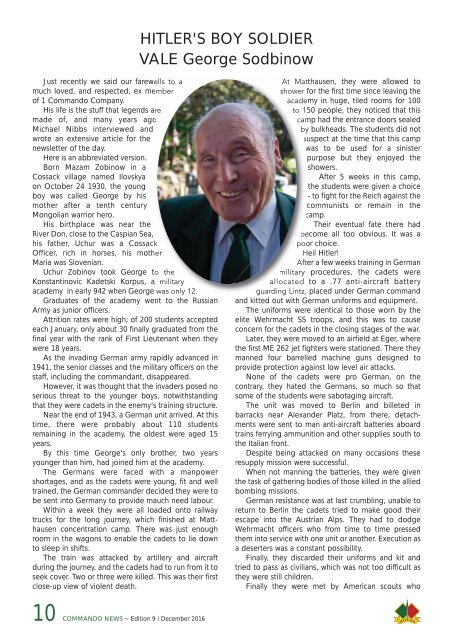Commando News December 2016
You also want an ePaper? Increase the reach of your titles
YUMPU automatically turns print PDFs into web optimized ePapers that Google loves.
HITLER'S BOY SOLDIER<br />
VALE George Sodbinow<br />
Just recently we said our farewells to a<br />
much loved, and respected, ex member<br />
of 1 <strong>Commando</strong> Company.<br />
His life is the stuff that legends are<br />
made of, and many years ago<br />
Michael Nibbs interviewed and<br />
wrote an extensive article for the<br />
newsletter of the day.<br />
Here is an abbreviated version.<br />
Born Mazam Zobinow in a<br />
Cossack village named Ilovskya<br />
on October 24 1930, the young<br />
boy was called George by his<br />
mother after a tenth century<br />
Mongolian warrior hero.<br />
His birthplace was near the<br />
River Don, close to the Caspian Sea,<br />
his father, Uchur was a Cossack<br />
Officer, rich in horses, his mother<br />
Maria was Slovenian.<br />
Uchur Zobinov took George to the<br />
Konstantinovic Kadetski Korpus, a military<br />
academy in early 942 when George was only 12.<br />
Graduates of the academy went to the Russian<br />
Army as junior officers.<br />
Attrition rates were high; of 200 students accepted<br />
each January, only about 30 finally graduated from the<br />
final year with the rank of First Lieutenant when they<br />
were 18 years.<br />
As the invading German army rapidly advanced in<br />
1941, the senior classes and the military officers on the<br />
staff, including the commandant, disappeared.<br />
However, it was thought that the invaders posed no<br />
serious threat to the younger boys, notwithstanding<br />
that they were cadets in the enemy's training structure.<br />
Near the end of 1943, a German unit arrived. At this<br />
time, there were probably about 110 students<br />
remaining in the academy, the oldest were aged 15<br />
years.<br />
By this time George's only brother, two years<br />
younger than him, had joined him at the academy.<br />
The Germans were faced with a manpower<br />
shortages, and as the cadets were young, fit and well<br />
trained, the German commander decided they were to<br />
be sent into Germany to provide mauch need labour.<br />
Within a week they were all loaded onto railway<br />
trucks for the long journey, which finished at Matt -<br />
hausen concentration camp. There was just enough<br />
room in the wagons to enable the cadets to lie down<br />
to sleep in shifts.<br />
The train was attacked by artillery and aircraft<br />
during the journey, and the cadets had to run from it to<br />
seek cover. Two or three were killed. This was their first<br />
close-up view of violent death.<br />
At Matthausen, they were allowed to<br />
shower for the first time since leaving the<br />
academy in huge, tiled rooms for 100<br />
to 150 people, they noticed that this<br />
camp had the entrance doors sealed<br />
by bulkheads. The students did not<br />
suspect at the time that this camp<br />
was to be used for a sinister<br />
purpose but they enjoyed the<br />
showers.<br />
After 5 weeks in this camp,<br />
the students were given a choice<br />
- to fight for the Reich against the<br />
communists or remain in the<br />
camp.<br />
Their eventual fate there had<br />
become all too obvious. It was a<br />
poor choice.<br />
Heil Hitler!<br />
After a few weeks training in German<br />
military procedures, the cadets were<br />
allocated to a .77 anti-aircraft battery<br />
guarding Lintz, placed under German command<br />
and kitted out with German uniforms and equipment.<br />
The uniforms were identical to those worn by the<br />
elite Wehrmacht SS troops, and this was to cause<br />
concern for the cadets in the closing stages of the war.<br />
Later, they were moved to an airfield at Eger, where<br />
the first ME 262 jet fighters were stationed. There they<br />
manned four barrelled machine guns designed to<br />
provide protection against low level air attacks.<br />
None of the cadets were pro German, on the<br />
contrary, they hated the Germans, so much so that<br />
some of the students were sabotaging aircraft.<br />
The unit was moved to Berlin and billeted in<br />
barracks near Alexander Platz, from there, detach -<br />
ments were sent to man anti-aircraft batteries aboard<br />
trains ferrying ammunition and other supplies south to<br />
the Italian front.<br />
Despite being attacked on many occasions these<br />
resupply mission were successful.<br />
When not manning the batteries, they were given<br />
the task of gathering bodies of those killed in the allied<br />
bombing missions.<br />
German resistance was at last crumbling, unable to<br />
return to Berlin the cadets tried to make good their<br />
escape into the Austrian Alps. They had to dodge<br />
Wehr macht officers who from time to time pressed<br />
them into service with one unit or another. Execution as<br />
a deserters was a constant possibility.<br />
Finally, they discarded their uniforms and kit and<br />
tried to pass as civilians, which was not too difficult as<br />
they were still children.<br />
Finally they were met by American scouts who<br />
10 COMMANDO NEWS ~ Edition 9 I <strong>December</strong> <strong>2016</strong>

















